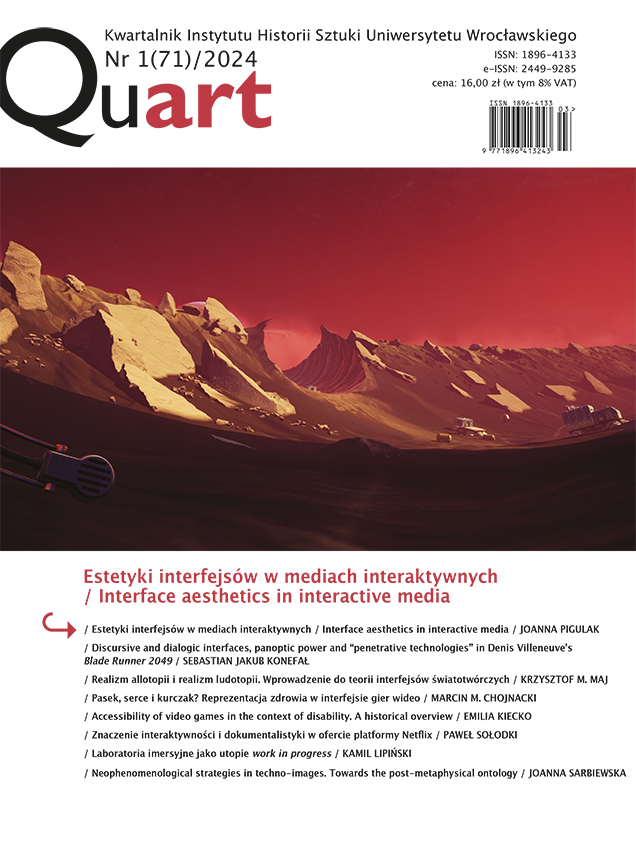

Artykuły

The article discusses the elements of the graphical user interface that inform the player about his character’s health. The author describes the basic health management systems in video games, discusses specific HUD functions that influence the gameplay, and proposes categories for distinguishing health bars. Additionally, the text mentions original examples of stylized representations of avatar injuries.
Brooksby Alan, Exploring the Representation of Health in Videogames: A Content Analysis, „Cyberpsychology & Behaviour” 2008, nr 6.
Brown Jim, Bridging the Gap Between UX Principles and Game Design, wystąpienie konferencyjne, „Game Developers Conference” 2018, https://www.youtube.com/watch?v=73Pqsk74Jc0 (data dostępu: 20.12.2023).
Brown Mark, How Games Do Health, kanał Game Maker’s Toolkit, https://www.youtube.com/watch?v=4AEKbBF3URE (data dostępu: 20.12.2023).
Brown Stuart, Chicken-o-meter, kanał Ahoy, https://www.youtube.com/watch?v=B8HT8aUb5q4 (data dostępu: 21.12.2023).
Call Josh, Bigger, Better, Stronger, Faster: Disposable Bodies and Cyborg Construction, [w:] Guns, Grenades, and Grunts: First-Person Shooter Games, ed. G. A. Voorhees, J. Call, K. Whitlock, New York 2012.
Engber Daniel, Who Made That Progress Bar?, https://www.nytimes.com/2014/03/09/magazine/who-made-that-progress-bar.html (data dostępu: 19.12.2023).
Fagerholt Erik, Lorentzon Magnus, Beyond the HUD: User Interfaces for Increased Player Immersion in FPS Games, praca magisterska napisana pod kierunkiem prof. S. Björka, Chalmers Tekniska Högskola, Göteborg 2009.
Gittens Curtis L., Gloumeau P. Christopher, Does a Segmented Health Bar Affect a Player’s Preference for a Game? A Pilot Study, [w:] 2015 IEEE Games Entertainment Media Conference, Toronto 2015.
Jørgensen Kristine, Gameworld Interfaces, Cambridge–London 2014.
Khazanehdarloo Aryan, Mohamed Karim, The Impact of Diegetic and Non-diegetic User Interfaces on the Player Experience in FPS Games, praca licencjacka napisana pod kierunkiem dr. K. M. Jää-Aro, Södertörn Högskola, Stockholm 2023.
Kubiński Piotr, Gry wideo. Zarys poetyki, Kraków 2016.
Llanos Stein C., Jørgensen Kristine, Do Players Prefer Integrated User Interfaces? A Qualitative Study of Game UI Design Issues, [w:] Proceedings of DiGRA 2011 Conference: Think Design Play, Utrecht 2011.
Marcus Aaron, Metaphor Design in User Interfaces, „Journal of Computer Documentation” 1998, nr 2.
Medina-Gray Elizabeth, Modular Structure and Function in Early 21st-Century Video Game Music, praca doktorska napisana pod kierunkiem prof. D. Harrisona, Yale University, New Haven 2014.
Myers Brad A., The Importance of Percent-done Progress Indicators for Computer-human Interfaces, [w:] CHI ’85: Proceedings of the SIGCHI Conference on Human Factors in Computing Systems, ed. L. Borman, R. Smith, New York 1985.
Perron Bernard, Sign of a Threat: The Effects of Warning Systems in Survival Horror Games, [w:] COSIGN 2004 Proceedings, ed. A. Clarke, Split 2004.
Plummer Tyriq, Made Out of Meat: Health Systems In Video Games, wystąpienie konferencyjne, „Game Developers Conference” 2016, https://www.youtube.com/watch?v=1nEJOkTjJqk (data dostępu: 20.12.2013).
Rogers Brandon, „Dude, How Much Health Do You Have Left?”: On Masculinity and the Rationalization of Health in Video Games, [w:] Krankheit in Digitalen Spielen Interdisziplinäre Betrachtungen, Hrsg. A. Görgen, S. H. Simond, Bielefeld 2020.